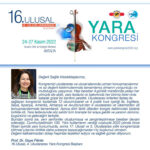What Is Pressure Ulcer?
A pressure ulcer is defined as localized damage to the skin and/or underlying tissue, as a result of
pressure or pressure in combination with shear. Pressure ulcers usually occur over a bony
prominence but may also be related to a medical device or other object.
It is called pressure ulcer because it forms when an area encounters long or restless pressure.
However, most commonly it is known as bed wound.
How these wounds form?
In bed or chair dependent patients, the pressure of the body weight puts pressure on the soft tissues.
The circulation of these tissues, which are squeezed between the bone bulge and the bed, defects
and eventually tissue damage occurs. When this damage reaches a certain level, a wound opens.
High friction and tight skin, high body temperature and wet skin cause the formation of wounds.
A pressure ulcer can develop even in 24 to 48 hours in a patient who remains in a fixed position and
progresses in a short time if necessary precautions are not taken and intervened immediately. An
early stage wound, which is normally expected to heal in 15 to 20 days, may worsen due to
continued pressure on the area, tissue edema and the development of infection with microorganisms
transmitted from urine and feces.
The first changes seen in the skin when a wound occurs are only the tip of the iceberg. Most tissue
damage starts under the skin and then shows itself on the skin surface. In short, when a rash or
wound is noticed on the skin, there is a high probability of more damage to the tissue underneath.
Therefore, it should not be neglected and a relevant center should be consulted immediately.
Where can a wound occur?
It can occur:
While sitting; on coccyx, on shoulder bone, on hip buttocks, elbows, heel
While lying down backwards; On the back of the head, on shoulder bones, buttocks, elbows, on
coccyx, heel, toes
While lying down on shoulder; ears, sides of the shoulders, sides of hipbone, hips, knees, side bulges
of ankles
While lying face down; Face, shoulders, hipbone, lap, knee, bulges of wrists.
(Some of the pictures below can be used- Sourcehttp://www.ouhsc.edu/geriatricmedicine/Education/PU/ulcer.htm#etiology.htm )
Which patients encounter these wounds more often?
• Critically ill individuals (receiving mechanical ventilation)
• Individuals with spinal cord injury
• Individuals receiving palliative care
• Individuals with obesity
• Neonates and children
• Individuals in community, aged care and rehabilitation settings
• Individuals in transit.
What to do to prevent pressure ulcer?
To prevent pressure ulcer, the points below should be taken into account.
Skin Assessment
Skin assessment is a key component of pressure ulcer prevention. Conduct a head-to-toe assessment
with particular focus on skin overlying bony prominences, including the sacrum, heels, hip, pubis,
thighs and torso. Include the occiput in a head-to-toe skin assessment for neonates and young children.
Routine skin and tissue assessment provides an opportunity for early identification and treatment of
skin alterations, especially pressure ulcers.
Preventive Skin Care
Maintaining skin integrity is essential in the prevention of pressure ulcers. Maintaining healthy skin requires comprehensive assessment and care. So, implement a skin care regimen that includes:
▪ Keeping the skin clean and appropriately hydrated
▪ Cleansing the skin promptly after episodes of incontinence
▪ Avoiding use of alkaline soaps and cleansers
▪ Protecting the skin from moisture with a barrier product.
▪ Avoid vigorously rubbing skin that is at risk of pressure injuries.
▪ Use high absorbency incontinence products to protect the skin in individuals with or at risk of
pressure ulcers who have urinary incontinence.
Nutrition
▪ Conduct a comprehensive nutrition assessment for adults at risk of a pressure ulcers who are
screened to be at risk of malnutrition and for all adults with a pressure ulcer.
▪ Optimize energy intake for individuals at risk of pressure injuries who are malnourished or at
risk of malnutrition.
▪ Adjust protein intake for individuals at risk of pressure ulcer who are malnourished or at risk
of malnutrition.
Repositioning And Early Mobilization
Repositioning and mobilizing individuals is an important component in the prevention of pressure
injuries so that:
▪ Reposition all individuals with or at risk of pressure injuries on an individualized schedule,
unless contraindicated.
▪ Determine repositioning frequency with consideration to the individual’s skin and tissue
tolerance, general medical condition, overall treatment objectives , comfort and pain.
▪ Reposition the individual in such a way that optimal offloading of all bony prominences and
maximum redistribution of pressure is achieved.
▪ Use the 30° side lying position in preference to the 90° side lying position when positioning.
▪ Keep the head of bed as flat as possible.

▪ Promote seating out of bed in an appropriate chair or wheelchair for limited periods of time.
▪ Select a reclined seated position with the individual’s legs elevated. If reclining is not
appropriate or possible, ensure that the individual’s feet are well-supported on the floor or on
footrests when sitting upright in a chair or wheelchair.
▪ Teach and encourage individuals who spend prolonged durations in a seated position to
perform pressure relieving maneuvers.

▪ Implement an early mobilization that increases activity and mobility as rapidly as tolerated.
▪ For individuals at risk of heel pressure ulcer, elevate the heels using a specifically designed heel
suspension device or a pillow/ foam cushion.
Support Surfaces
Support surfaces are “specialized devices for pressure redistribution designed for management of
tissue loads, microclimate, and/or other therapeutic functions (i.e., any mattress, integrated bed
system, mattress replacement, overlay, or seat cushion, or seat cushion overlay).”
• Continue to reposition individuals regardless of the type of pressure redistribution support
surface being used.
• Select a support surface that meets the individual’s need for pressure redistribution based on
the following factors:
• Level of immobility and inactivity
• Need to influence microclimate control and shear reduction • Size and weight of the
individual
• Number, severity and location of existing pressure injuries • Risk for developing new
pressure injuries.
▪ And also when selecting a support surface, consideration should be given to where the
support surface and/or bed will be placed. Consider:
• Weight of the bed
• Structure of the building, including width of doors
• Availability of uninterrupted electrical power
• Safe location for the pump or motor, including its ventilation.
▪ For individuals with obesity, select a support surface with enhanced pressure redistribution,
shear reduction and microclimate features.
▪ Use a high specification reactive single layer foam mattress or overlay in preference to a
foam mattress without high specification qualities for individuals at risk of developing
pressure injuries.
▪ Consider using a reactive air mattress or overlay for individuals at risk for developing
pressure injuries.
▪ Assess the relative benefits of using an alternating pressure air mattress, overlay or medical
grade sheepskin for individuals at risk of pressure injuries.
▪ Select a seat and seating support surface that meets the individual’s need for pressure
redistribution with consideration to body size and configuration, effects of posture and
deformity on pressure distribution, mobility and lifestyle needs.
▪ Use a pressure redistribution cushion for preventing pressure injuries in people at high risk
who are seated in a chair/wheelchair for prolonged periods, particularly if the individual is
unable to perform pressure relieving maneuvers.








